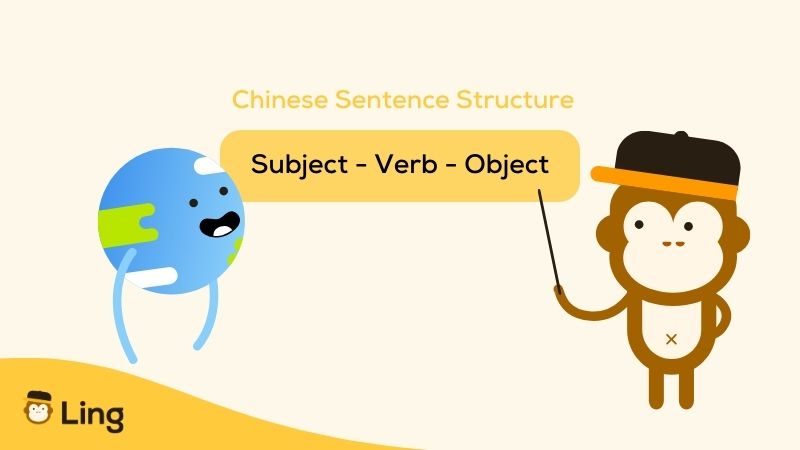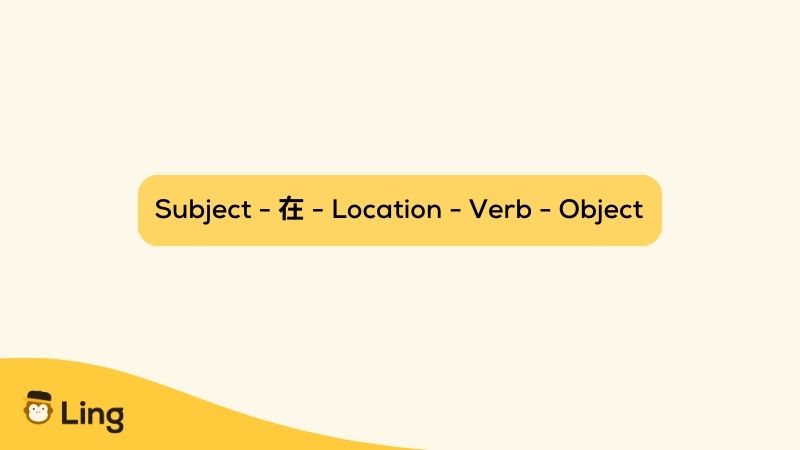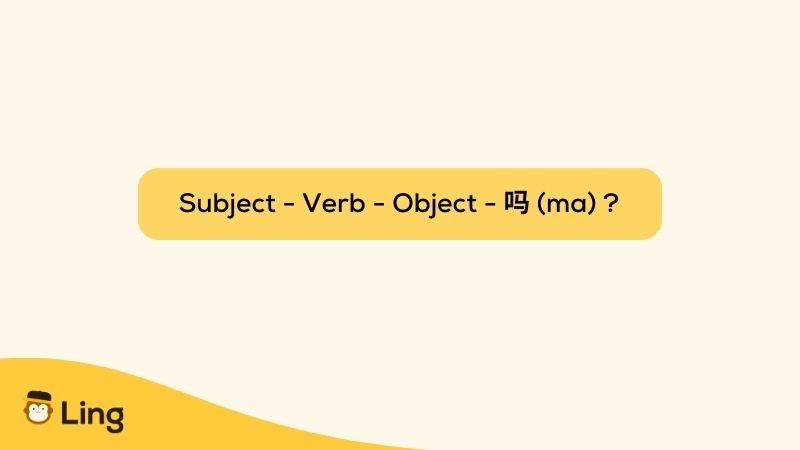A lot of people think Chinese grammar is difficult, but that’s not true! In fact, most European languages have a more difficult grammar than Chinese. Why? Because there are no confusing verb conjugations, masculine and feminine nouns, singular and plural forms in the Chinese language, not at all! You may even be surprised to hear that the basic Chinese sentence structure is SVO, just like English!
In this article, you will learn the most important aspect of basic Chinese grammar: sentence structure. You will learn several basic patterns to form different kinds of sentences. And as you’re reading this article, you’ll see that Chinese is actually a very logical language.
So, if you’re ready, let’s get started!

Basic Chinese Sentence Structure
Similar to English, in the Chinese grammar, the basic Chinese sentence structure has this word order:
Subject – Verb – Object
But unlike English, the verb doesn’t change according to the subject. For example, when we say “He sleeps.” we add an -s to the verb. In Chinese, it would be “He sleep”. The same rule applies when the subject is plural or singular; it doesn’t matter. No verb conjugation!
Examples:
- I eat apples – 我吃苹果 (Wǒ chī píngguǒ)
- He drinks tea. – 他喝茶 (Tā hē chá)
- She writes books. – 她写书 (Tā xiě shū)
- We learn Chinese. – 我们学汉语 (Wǒmen xué hànyǔ)
- They play games. – 他们玩游戏 (Tāmen wán yóuxì)
Adding Time To A Chinese Sentence
When you want to express time in a sentence, you should add the time words right after the subject. The pattern is:
Subject – Time Words – Verb – Object
If you want to express a day and time in Chinese, like “6 PM today”, you should invert the sentence order. So it would be “today 6 PM.”
Here is some Chinese vocabulary for common time words:
| English | Chinese | Pinyin |
|---|---|---|
| Now | 现在 | Xiànzài |
| Today | 今天 | Jīntiān |
| Yesterday | 昨天 | Zuótiān |
| Tomorrow | 明天 | Míngtiān |
| Morning (AM) | 上午 | Shàngwǔ |
| Afternoon (PM) | 下午 | Xiàwǔ |
| Evening/Night | 晚上 | Wǎnshàng |
Examples:
- I eat apples every day – 我每天吃苹果 (Wǒ měitiān chī píngguǒ)
- He drinks tea every evening – 他每晚喝茶 (Tā měi wǎn hē chá)
- She is writing a book now – 她现在写书 (Tā xiànzài xiě shū)
- We will learn Chinese tomorrow – 我们明天学汉语 (Wǒmen míngtiān xué hànyǔ)

Adding Location To A Chinese Sentence
When you want to express location in Chinese sentences, you should add the location word right after the subject and time. You also have to add zài (在), which can be translated as “in, on, at” in English, before any location. The pattern looks like this:
Subject – 在 – Location – Verb – Object
Also, to express a Chinese address like “Shangai, China,” you should invert it. So it would be “China, Shangai.” These sentences should always go from the largest to the smallest area, as below:
Country > City > Town > Neighborhood > Street, etc.
Here is some Chinese vocabulary you can use for common location words:
| English | Chinese | Pinyin |
|---|---|---|
| City | 城市 | Chéngshì |
| Town | 镇 | Zhèn |
| Village | 村庄 | Cūnzhuāng |
| Country | 国家 | Guójiā |
| State/Province | 省 | Shěng |
| County | 县 | Xiàn |
| Airport | 机场 | Jīchǎng |
| Train Station | 火车站 | Huǒchēzhàn |
| Bus Stop | 公交车站 | Gōngjiāochēzhàn |
| Park | 公园 | Gōngyuán |
| Beach | 沙滩 | Shātān |
| Mountain | 山 | Shān |
| Lake | 湖 | Hú |
| Forest | 森林 | Sēnlín |
| Desert | 沙漠 | Shāmò |
| Coast | 海岸 | Hǎi’àn |
| Square | 广场 | Guǎngchǎng |
| Bridge | 桥 | Qiáo |
| Hotel | 酒店 | Jiǔdiàn |
| Restaurant | 餐厅 | Cāntīng |
| Museum | 博物馆 | Bówùguǎn |
| Library | 图书馆 | Túshūguǎn |
| Hospital | 医院 | Yīyuàn |
| School | 学校 | Xuéxiào |
Examples:
- I eat apples at home every day – 我每天在家吃苹果 (Wǒ měitiān zài jiā chī píngguǒ)
- He drinks tea in the office every evening – 他每晚在办公室喝茶 (Tā měi wǎn zài bàngōngshì hē chá)
- She is writing a book in the library now – 她现在在图书馆写书 (Tā xiànzài zài túshūguǎn xiě shū)
- We will learn Chinese at school tomorrow – 我们明天在学校学汉语 (Wǒmen míngtiān zài xuéxiào xué hànyǔ)
Making Question Sentences In Chinese
Now, it’s time to learn how to form question sentences in the Chinese language. You will learn two ways to create question sentences: “wh-” questions and yes/no questions.
“Wh-” Questions
The most common way to construct question sentences is by using question words. The most important rule when making questions in Chinese is that the word order doesn’t change. You just have to add a question word or interrogative pronoun.
Let’s look at these examples to understand it better:
- Who eats apples at home every day? – 谁每天在家吃苹果? (Shuí měitiān zài jiā chī píngguǒ?)
- When does he drink tea in the office every evening? – 他每晚在办公室喝茶的时候是什么时候? (Tā měi wǎn zài bàngōngshì hē chá de shíhòu shì shénme shíhòu?)
- Where is she writing a book now? – 她现在在哪里写书? (Tā xiànzài zài nǎlǐ xiě shū?)
- Where do you usually watch TV? – 你通常在哪里看电视? (Nǐ tōngcháng zài nǎlǐ kàn diànshì?)
Here is a list of “wh-” question words in Chinese:
| English | Chinese | Pinyin |
|---|---|---|
| Who | 谁 | Shuí |
| What | 什么 | Shénme |
| When | 什么时候 | Shénme shíhòu |
| Where | 哪里 | Nǎlǐ |
| Why | 为什么 | Wèishénme |
| How | 怎么 | Zěnme |

Yes/No Questions With Ma (吗)
To form yes/no questions in Chinese, you should use the particle ma (吗). All you have to do is to add it at the end of the sentence, and you have a question.
For example, Nǐ xǐhuān kāfēi (你喜欢咖啡) means “you like coffee“. To turn this statement into a yes/no question, add 吗 (ma) at the end of it. We then have Nǐ xǐhuān kāfēi ma? (你喜欢咖啡吗?) which becomes “Do you like coffee?“
Here are more examples:
- Do you eat apples at home every day? – 你每天在家吃苹果吗? (Nǐ měitiān zài jiā chī píngguǒ ma?)
- Does he drink tea in the office every evening? – 他每晚在办公室喝茶吗? (Tā měi wǎn zài bàngōngshì hē chá ma?)
- Is she writing a book in the library now? – 她现在在图书馆写书吗? (Tā xiànzài zài túshūguǎn xiě shū ma?)
- Do you usually watch TV in the living room? – 你通常在客厅看电视吗? (Nǐ tōngcháng zài kètīng kàn diànshì ma?)
Keep in mind, though, that you can’t use ma (吗) at the end of a “wh-” question!
Making Sentences With Shì (是)
Now, you’ll learn how to make simple statements to identify something by using the particle Shì (是), which is similar to the verb “to be” in English. Usually, shì (是) is used to identify people or objects. It is placed between the subject and the object:
Subject – Shì (是) – Object
Examples:
- He is a teacher – 他是老师 (Tā shì lǎoshī)
- We are friends – 我们是朋友 (Wǒmen shì péngyǒu)
- This is my home – 这是我的家 (Zhè shì wǒ de jiā)
- Today is Wednesday – 今天是星期三 (Jīntiān shì xīngqī sān)
Keep this in mind: You can’t use it as the exact correspondence to the English verb “to be.” That’s because you can’t use it for sentences like “I’m here” (You’re telling where you are; you’re not identifying yourself) or “I’m hungry” (You’re describing a condition, not identifying yourself).

Making Negative Sentences In Chinese
Last but not least, let’s finish this article by learning how to form negative sentences in Chinese.
It’s really simple. The particle bù (不) is similar to “not” in English. So, to form a negative sentence, you have to keep the basic SVO structure and place bù (不) right before the verb:
Subject – Bù (不) – Verb – Object
Examples:
- I don’t drink coffee – 我不喝咖啡 (Wǒ bù hē kāfēi)
- He is not happy – 他不高兴 (Tā bù gāoxìng)
- This dish is not spicy – 这个菜不辣 (Zhège cài bù là)
- We are not going to the mall – 我们不去商场 (Wǒmen bù qù shāngchǎng)
Negative Sentences Using “To Have”
For the verb yǒu (有), or “to have,” you can’t use bù (不) to make it negative. If you want to talk about what you don’t have, use the adverb méi (没) instead.
Subject – Méi (没) – Yǒu (有) – Object
Below are a few sentences using ‘not have.’
Examples:
- I don’t have a cell phone – 我 没 有 手机 (Wǒ méi yǒu shǒujī)
- We don’t have a house – 我们 没 有 房子 (Wǒmen méi yǒu fángzi)
- I don’t have Chinese friends – 我没有中国朋友 (Wǒ méi yǒu Zhōngguó péngyǒu)
- My card does not have money – 我的卡里没有钱 (Wǒ de kǎ lǐ méi yǒu qián)
Summary
I know this was a long article, and it may be hard to grasp all the sentence patterns above. So, why don’t we summarize the basic Chinese sentence structures in a single table?
| Sentence Type | Structure |
|---|---|
| Basic sentence | Subject – Verb – Object |
| Add time | Subject – Time Words – Verb – Object |
| Add location | Subject – zài (在) – Location – Verb – Object |
| Question sentence | Subject – Verb – Object – ma (吗) |
| Negative sentence | Subject – bù (不) – Verb – Object |
Start Learning Chinese With Ling!
Want to learn Chinese? The Ling app offers more than 60 foreign language courses, including Chinese!
The Ling app can help you learn to write Chinese characters, understand native speakers, and do many mini-activities to learn vocabulary. You can even review what you have learned at the end of each lesson. And that’s not all! You can practice your pronunciation and conversational skills by talking to our friendly chatbot.
Download the Ling app on your mobile device from the Play Store or App Store to start learning Chinese now!
Hey, don’t forget to visit Ling’s Chinese blog weekly to learn more about this culture and its language!

































































